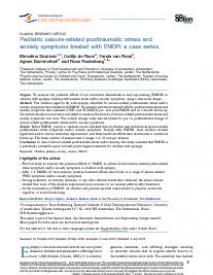Pediatric seizure-related posttraumatic stress and anxiety symptoms treated with EMDR: a case series
Purpose: To examine the potential effects of eye movement desensitization and reprocessing (EMDR) in children with epilepsy-related posttraumatic stress and/or anxiety symptoms, using a case series design.
Methods: Five children (aged 8–18) with epilepsy identified for seizure-related posttraumatic stress and/or anxiety symptoms were treated with EMDR. To examine potential treatment effects, posttraumatic stress and anxiety symptoms were assessed (CRTI and SCARED) pre- and post-EMDR and at 3-month follow-up. Normative deviation scores were calculated to examine the severity of seizure-related posttraumatic stress and anxiety symptoms over time. The reliable change index was calculated for pre- to posttreatment change of seizure-related posttraumatic stress and/or anxiety symptoms.
Results: Before EMDR, overall or subscale scores indicated that all children had (sub)clinical seizure-related posttraumatic stress symptoms and/or anxiety symptoms. Directly after EMDR, most children showed significant and/or clinical individual improvement, and these beneficial effects were maintained or reached at follow-up. The mean number of sessions was 2 (range 1–3, 45 min per session).
Conclusions: In case of seizure-related posttraumatic stress and/or anxiety, this study indicates that EMDR is a potentially successful quick and safe psychological treatment for children with epilepsy.
In: European journal of psychotraumatology, ISSN 2000-8066 | 7 | 30123
http://www.ejpt.net/index.php/ejpt/article/view/30123


